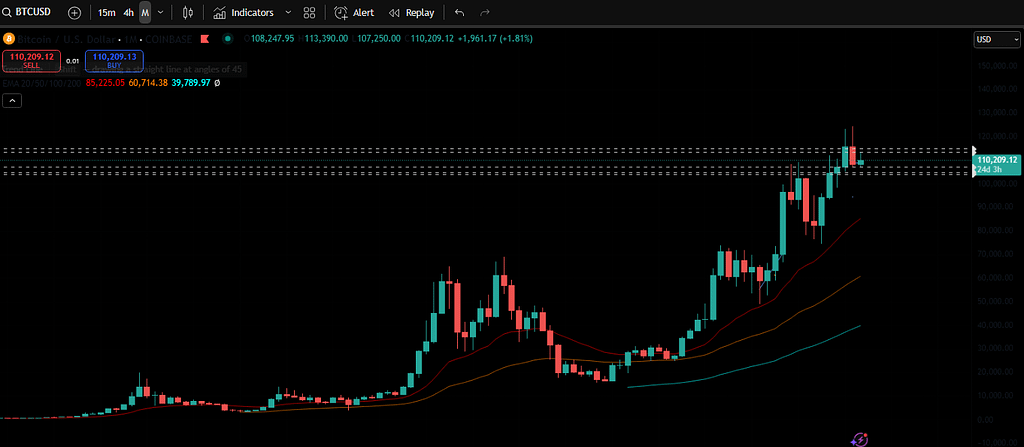I’ve been in Bitcoin since 2013. That’s twelve and a half years of staring at charts, reading news, and surviving the wildest financial rollercoaster humanity has ever seen. Honestly, I feel a hundred years old by now. But I still love the industry I chose to dedicate my life to.
Today, I want to dive into one of the most famous patterns in crypto: the Bitcoin 4-year cycle, also called the halving cycle. With Wall Street, ETFs, and institutions flooding into Bitcoin, the question is simple: can we still rely on the 4-year cycle? Or is this pattern about to break for the first time?
Study our latest trading guide which breaks down “moving averages“
What Is the 4-Year Cycle?
The 4-year cycle is built around Bitcoin’s halving. Roughly every four years, the block reward is cut in half. This lowers the new supply of Bitcoin entering the market. In past cycles, this shock to supply triggered big bull runs, followed by painful bear markets.
Historically, the pattern looked like this:
- Year 1: Accumulation after the bear.
- Year 2: Steady climb.
- Year 3: Parabolic bull run.
- Year 4: Brutal bear market.
Rinse and repeat. Since 2012, this pattern has been surprisingly consistent.

Arguments for the Cycle Still Being Intact
The Supply Shock Never Changes
The halving event doesn’t care about institutions, ETFs, or Wall Street. It still cuts the supply in half. Less supply, same or higher demand, usually equals higher prices.
Think of it like a natural law coded into Bitcoin itself. Until the last satoshi is mined, the halving is a rhythm that ticks like clockwork.
History Loves to Rhyme
If you compare the 2016–2020 cycle with the 2020–2024 one, the similarities are eerie. Both had early bull markets, mid-cycle corrections, and then explosive growth near the halving.
I remember back in 2017, I thought Bitcoin going from $1,000 to $20,000 was insane. Then in 2021, we watched it push to $69,000. The patterns felt familiar. This kind of rhythm creates psychology. Traders expect it, and that expectation becomes part of the market’s behavior.
Macro Liquidity Matters
Global M2 money supply is another factor. Whenever liquidity expands, risk assets pump. Bitcoin is tied to that cycle now. And interestingly, the global liquidity cycle often aligns with Bitcoin’s halving. This synchronicity keeps fueling the narrative that Bitcoin is still dancing to the 4-year beat.

Arguments Against the Cycle Holding Up
Institutions Change the Game
Wall Street doesn’t care about memes or halving hype. It cares about liquidity, hedging, and portfolio allocation. With spot Bitcoin ETFs now absorbing billions, Bitcoin may start to follow flows from big money rather than halving-driven supply shocks.
I’ve spoken with traders who barely look at halvings. For them, it’s about Fed policy, bond yields, and dollar strength. If institutions dominate, maybe the cycle becomes less about Bitcoin’s internal mechanics and more about macro cycles.
The Market Is Too Mature
Bitcoin in 2013 was a fringe toy. In 2017, it was still niche. By 2021, it became mainstream. Now in 2025, Bitcoin is a $2 trillion asset with major corporate and government exposure.
Big assets tend to smooth out volatility over time. Gold doesn’t have 80% drawdowns anymore. Bitcoin might eventually lose the explosive cycle and settle into a more stable trajectory.
Halvings Are Priced In
Efficient market theorists will tell you halvings aren’t surprises. Everyone knows they’re coming. Futures markets, ETFs, and miners all prepare years in advance. If supply shocks are anticipated, then maybe they lose their power.
The real volatility could come from unexpected events: regulations, wars, or Black Swan crashes.

Where Do We Stand Today?
Here’s where I land. I still lean toward the 4-year cycle being intact. Maybe not forever, but at least for now.
We had the halving in April 2024. If history repeats, Bitcoin should top around October 2025. That would give us one more parabolic leg up before the cycle completes. After that, we’d see a sharp correction and then—hopefully—a small altcoin season to make things interesting.
It feels almost too simple, but sometimes markets love simple narratives. And Bitcoin has been teaching us for more than a decade that it thrives on cycles.
If you believe in one last leg up, check these 6 alts we’re currently trading.
Personal Reflection
I’ll be honest: every cycle feels harder. In 2013, I mined Dogecoin for fun and bought Bitcoin at $44. Back then, nobody cared. Today, I’m competing with trillion-dollar asset managers for entry points.
But that’s the magic of this space. The longer you stay, the more you see. Whether the 4-year cycle breaks or holds, being here is a front-row seat to financial history.
I’d bet most of us will still check the halving dates and circle October on our calendars. Because deep down, we love the idea that Bitcoin still plays by its old rules.
Support Our Work
If you found this helpful, consider signing up on BloFin (Non-KYC) or Bybit using our referral links. Your support keeps this content free and flowing.
Final Thoughts
The 4-year cycle is part math, part psychology, and part tradition. Maybe institutions will change it, maybe not. But for now, it’s still a useful compass for navigating Bitcoin’s storms.
If history holds, the next twelve months should be fireworks. And if it doesn’t, well, that’s Bitcoin for you—always ready to humble us.
So, is the 4-year cycle still intact? The jury’s out. But my gut says yes. And if that’s true, we might be staring down another legendary top around October.
Better fasten your seatbelt.
If you enjoyed this blog, go check out our latest blog about Ethereum.
As always, don’t forget to claim your bonus below on Bybit. See you next time!



